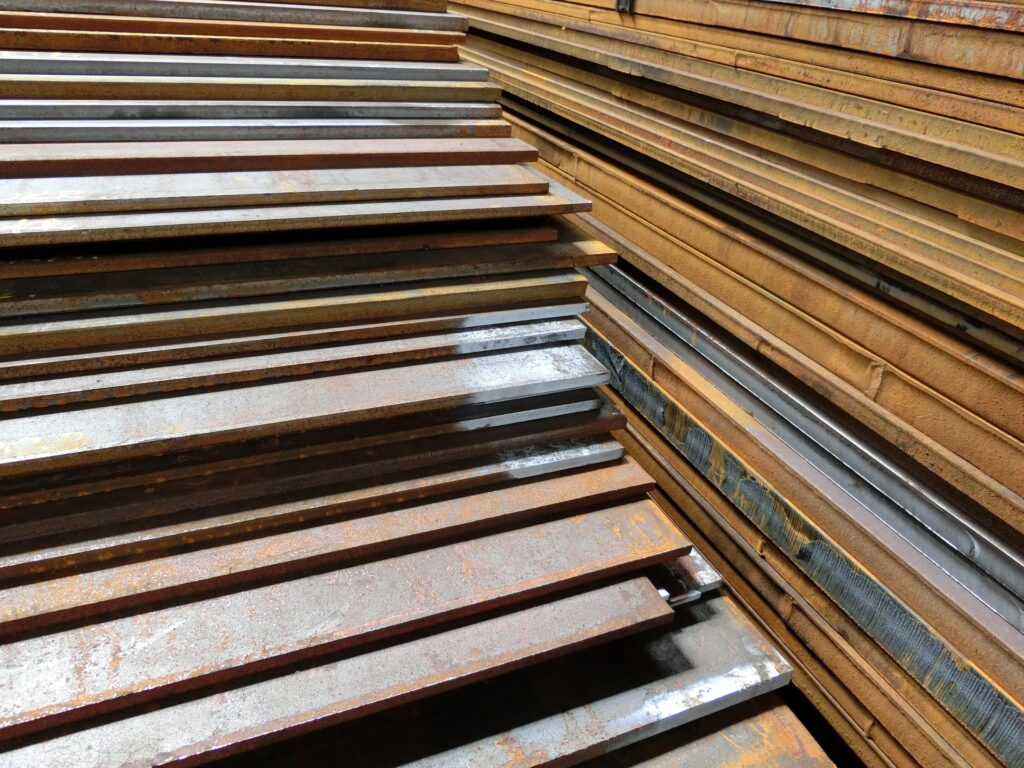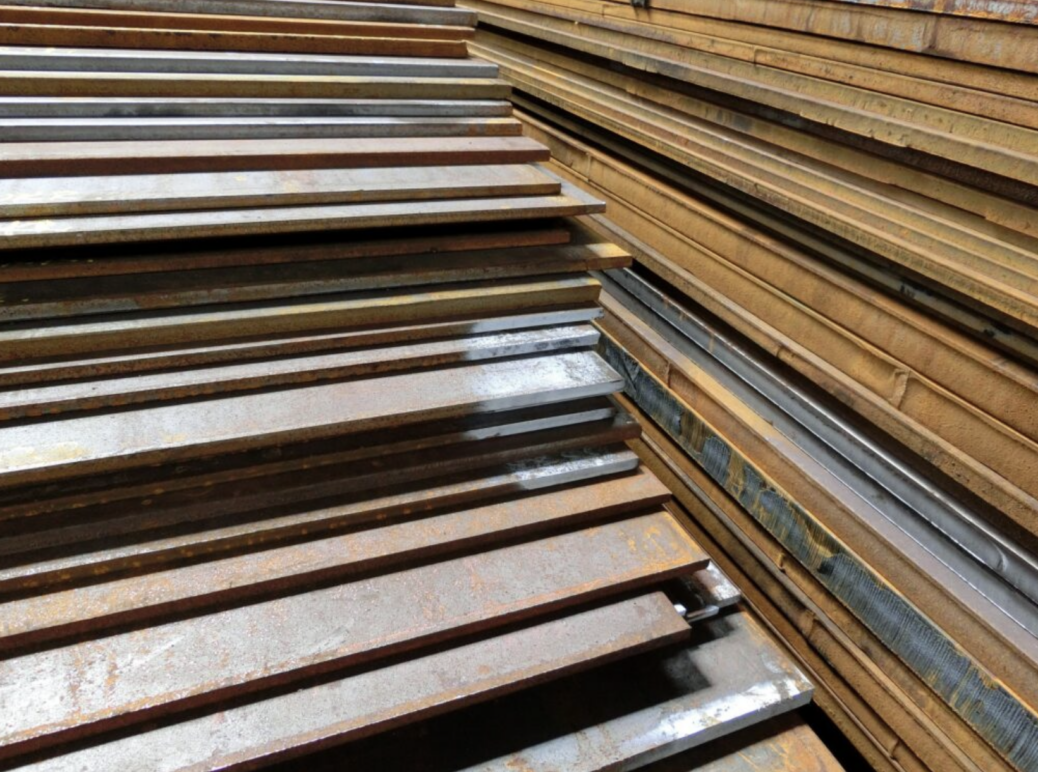
Construction of bridge, machinery, ship, agricultural machines, construction machinery components such as cranes and excavators, projects of infrastructural facilities, and residential/commercial buildings are some of the usage areas of structural steels. Completed steel products should go through a couple of metal treatment processes.
By reading our article, you will learn:
- What exactly structural steel is;
- The elemental composition structural steels have;
- Mechanical and physical properties of structural steels;
- Further knowledge in durable and high strength steels;
- What differences exist are between structural and machinery/tool steels
Structural Steel
Structural steels are mainly used in buildings and bridges. It contains roughly 0.25% carbon, depending on the application requirements. The main types of structural steel are S355, S235, and S275 from S series but it is not limited to just three types. There are plenty, but for now, they are out of the scope of this post.
These steels are globally characterized by the following properties below:
- They have low carbon.
- They are softer and more ductile.
- They can be easily shaped hot or cold.
- They can be properly welded without becoming brittle
- They are usually produced in large dimensions for construction purposes.
European Standards for S Series
Structural steel produced in Europe must be in accordance with EN 10025 EU Standard. Other types of S series structural steels worth mentioning are 460, 420, 195, 235, 355, and 275. This article will be focusing on 235, 275, and 355 types which are the most frequently selected types of S series for construction projects.
Designation of S235
S235 summarizes the properties of this particular structural steel. For instance, the letter “S” in S series is an indication of a “structural” type of steel. The number 235 is an indicator of the yield stress of the material (235 MPa – N/ mm²) at 16 mm thickness. After this point, plastic deformation will start which is irreversible. Additional designations give more information about the material. These are usually combinations of letters and numbers such as K2, W, C, Z, JO, JR, N, NL, J2, QL, Q, ML, or M besides the “S” in the S series.
- S = Structural
- The last three digits = Indicate the yield point in MPa.
- K2, J2, JO, JR = Brittleness determined in impact testing
- W = Weathering property
- Z = Directional tensile test designation, Z (35, 25, 15) quality
- C = Containing a high amount of carbon, good to roll coldly.
- N = Annealed, normalized, and rolled steels
- NL = Annealed, normalized, and rolled steels having minimum specified impact strength under -50 °
- Q = Quenched and tempered steels
- QL = Quenched and tempered steels having minimum specified impact strength under -50 °
- M = Thermomechanically rolled steels
- ML = Thermomechanically rolled steels having minimum specified impact strength under -50 °
Explore more Click here to find information about notch impact testing and values.
Chemical compositions of S355, S275, and S235
Elemental composition is the most important and determinant factor that affects everything about steel. Physical and mechanical properties solely depend on the chemical composition of the steel. Since it is of great importance, chemical compositions are under the supervision of EN standards established by Europeans. The elemental ingredient differs according to the purpose of use. Let us consider S235J2 structural steel for instance. It is a type of structural steel with an enhanced hardness value, thus it is different from regular S235 to some extent. The responsible authorities of a project must consider the chemical composition of the steel carefully, suitable for their intent.
Maximum additions of different elements into a steel can be seen below in the table for S355, S275, and S235 from S series structural steels.
| Grade of steel | Maximum % carbon (C) | Maximum % manganese (Mn) | Maximum % phosphorus (P) | Maximum % sulphur (S) | Maximum % silicon (Si) |
| S235 | 0.22 | 1.60 | 0.05 | 0.05 | 0.05 |
| S275 | 0.25 | 1.60 | 0.04 | 0.05 | 0.05 |
| S355 | 0.23 | 1.60 | 0.05 | 0.05 | 0.05 |
Mechanical properties of S355, S275, and S235 From S Series
Chemical composition is the ultimate parameter in the determination of mechanical properties. The mechanical properties of a structural steel give plenty of information on whether it is suitable or not for that purpose. Mechanical properties consist of toughness, hardness, stiffness, and so on but the most significant mechanical properties are tensile and yield strength. Even the nomenclature of these steels is done according to their yield strength.
Here you can find our extensive discussion about the properties of materials.
Yielding of S355, S275, and S235
No matter what exactly the usage is, yield strength is arguably the most significant mechanical property of structural steel. It is determined by tensile testing and it can be examined on the stress-strain curve. Plastic deformation starts to occur at the yield point and the yield strength is where that specific point addresses in the stress (MPa) axis. It is the minimum amount of force for which the irreversible plastic deformation begins to occur. Producer and user both attach importance to yield point.
The producer decides how much force is needed to be applied in order to give the structural steel the desired geometry. By reading the yield strength value, users know where and how to use structural steel components in construction projects. Materials having relatively low yield strength cannot withstand static loads for too long.
Tensile testing of S355, S275, and S235 from S series
A tensile test is applied to the sample materials to determine the ultimate tensile strength point where necking starts to occur. It indicates the maximum stress value which a material can withstand. However, in practice, yield strength is much more significant than ultimate tensile strength since, after yield point, the material is already deformed and unusable in static constructions. If plastic deformation has been already begun, it will surely break at some point. Of course, ultimate tensile strength is not a property to be ignored completely. Some of the values can be read from the table located below. Like the yield strength, tensile strength values can also be found in the stress-strain curve.
By clicking, you can find out more about the stress-strain curves of S Series.
| Grade of steel | Yield point in MPa | Ultimate Tensile strength in MPa |
| S235 | 235 MPa | 310 – 510 MPa |
| S275 | 275 MPa | 370 – 530 MPa |
| S355 | 355 MPa | 470 – 630 MPa |
Structural Steels yield strength and ultimate tensile strength in 16mm thickness.
An array of processes must be done on the produced product, which are plasma/laser cutting, edging, welding, and milling.
Durable and High Strength Steels
There exist various kinds of steel, such as Weldox steel that has the highest yield strength (1300 MPa) without additional alloying. These types of steels are commonly known as high-strength, having exceptional values of yield strength. Dillimax and Domex are other most widely commonly known types of high-strength steels. They are benefited from crane components and structures that must be standing in a high amount of loads. There also exists steels having high values of hardness for specific purposes: For instance, Hardox 500 and 450 steels with 500 and 450 Brinell hardness respectively. Before you begin on your research, you can check out the available stocks of ours by just clicking here.
Explore more about the advantages of high strength steels
Machine and Tool Steels
Machine steels
Machine steels have carbon content around 0.3% – 0.6%. It contains a relatively low amount of alloying elements, roughly 1.5% to 5% molybdenum, vanadium, chromium, and nickel content. As it can be understood from its name, this kind of steel is generally benefited in machinery, usually in the internal components. These components include keys, couplings, gears, etc. Machine steels are usually characterized by the following properties:
- More hard and strong
- Enables precise cutting
- Impossible to deform cold and just to some extent when hot.
- Hardened when welded
- Can be alloyed both in low and high amount
Tool steels
Tool steels have carbon content around 0.6% – 1.5%. It is extremely hard due to its high carbon content. Alloying elements are generously added with ratios exceeding 5%. Another name for tool steels is High-Speed Steels (HSS) since they are used in high-speed operations such as cutting and drilling. Friction heat generated by high-speed operations causes the temperature to rise but they protect their hard nature even at elevated temperatures. Like in every metal and alloy, mechanical properties are determined by chemical composition and heat treatment practices done on material.
- High hardness and strength
- Resistance to knock
- Easily modified
- Highly alloyed
You May Be Interested
- A comprehensive guide to structural steel
- Minimum Radius for A Proper Bending
- 4 Latest Technologies in Steel Industry
- What Is an I Beam and Why Is It Used?


